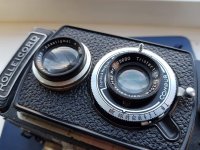hap
Well-known
MTF shows three dimensional characteristics of lenses perfectly if it is presented three-dimensionally, but it basically never is presented that way. A manufacturer typically measures or calculates MTF at 50x the focal length, or, increasingly and frustratingly, wherever MTF is calculated to look best (“our Bragicron is better than your Corvus!!!”). To show MTF this way you need either a mutidimensional model output or, to visualise it, a chart per f stop and frequency response. It makes the whole thing vastly harder to read, quite a challenge given how basic 2-D MTF charts are typically misinterpreted.
Modern glass, coating and manufacturing techniques make arguments about the number of elements moot - lens designers can use as few or as many as they choose. One overlooked factor is that the fewer elements you have, the greater the mechanical precision required for manufacture, because the same proportional misalignment causes a greater optical change in the imaging characteristics.
Marty
I could be wrong as I am far from knowledge of lens design. However, it seems that is the strategy of Miyazaki of MS Optical. Exploring the potential of modern glass and coatings to update simple and fewer number element lens designs of "old".
However, having owned a MS Optic sonnar the haptics are quirky. I'd like to try a 21mm f4 triplet Perar.
hap
Well-known
Curved sensors is a great idea if the field curvature of every lens in a series can be made to curve in the identical fashion.
Wouldn't it be wonderful if sensors could be variably flexed to accommodate any particular lens.
Could they not simulate any curvature?
KoNickon
Nick Merritt
This is a case where a system analogous to the Kodak Retina IIIC and early Retina Reflex could be employed.
Phil Forrest
Can you shed more light on this? How do those cameras work? Thanks.
Phil_F_NM
Camera hacker
Can you shed more light on this? How do those cameras work? Thanks.
They used a leaf shutter and not a focal plane shutter. Behind the leaf shutter was a fixed optical group built in to the camera which could not be changed. In front of the shutter was a bayonet fitting where the optical group which would change the effective focal length of the whole lens system. If a similar system were built in to a digital camera, the rear optical block could be optimized for keeping the light perpendicular to the whole imaging plane, which is the whole problem that non-retrofocus lenses have in interchangeable lens digital cameras.
This is an ungainly kludge of a workaround though, but it could reduce some of that aberration. We've been viewing digital images through 3 chip systems for decades now, all of those have intermediate glass to correct for different wavelengths and are stitched back together in the final image.
Phil Forrest
f.hayek
Well-known
Could they not simulate any curvature?
For a fixed lens camera, yes. You design the sensor to fully mimic the lens.
For an interchangeable lens body, each individual lens will invariably have a different curvature of field. Unless the curvature of the sensor can be changed as need in such a scenario, the sensor cannot be optimized.
rgeorge911
Established
I have the cheap Nikon zoom the OP mentions and have always marveled at how nice the images it makes are. I don’t use it much but have never let it go, which says something; I sell gear that I’m not attached to. It is not clinically sharp, but renders very nicely, especially in color. All IMO.
benlees
Well-known
Curved sensors is a great idea if the field curvature of every lens in a series can be made to curve in the identical fashion.
Wouldn't it be wonderful if sensors could be variably flexed to accommodate any particular lens.
Nice! You dream big! I would be happy with a fixed lens camera.
Pioneer
Mentor
I am very fond of simple designs. As a general rule I find Tessars and Triplets to be terrific lenses. Tessars seem to be a little better wide open than most Triplets but in real life photography the difference is far less than is often presented on these camera forums.
But that is ok. As a rule I can buy a Triplet lens for large format or in medium format TLRs and folders for FAR less than the more expensive lens formulas.
But that is ok. As a rule I can buy a Triplet lens for large format or in medium format TLRs and folders for FAR less than the more expensive lens formulas.
flavio81
Well-known
Modern glass, coating and manufacturing techniques make arguments about the number of elements moot - lens designers can use as few or as many as they choose.
It also means few optical groups will give even higher flare resistance and the potential for even higher contrast too.
A concrete example is the Pentax-M 40/2.8 from the late 70s. A deluxe "advanced tessar" type (5/4 structure) with advanced glasses (see Marco Cavina's article) full multicoating in all surfaces. Popular photography tested it to have the lowest flare levels of all lenses up to that date. And this is already well into the "multicoated lenses" era.
flavio81
Well-known
I am very fond of simple designs. As a general rule I find Tessars and Triplets to be terrific lenses. Tessars seem to be a little better wide open than most Triplets but in real life photography the difference is far less than is often presented on these camera forums..
Stopped down they're supposed to be almost equal in performance, if well computed (and well made; optical positioning is important...)
I've just ordered a new triplet for my camera...
Ambro51
Collector/Photographer
Back in my Wet plate days, using a Petzval portrait lens, a favorite trick was to remove the rear cell, and replace it with the front achromat, reversed. In front of this, in the Waterhouse stop slot, an f 11 or so stop was inserted. This gave a long focus lens with pinpoint sharpness.
Noserider
Christiaan Phleger
I recall a period of time when I encountered a few copies of the Nikon E series 36-72mm f/3.5, which was supposed to be a 'updated budget 43-86mm replacement for the Nikon EM and FG. I didn't think much of them at the time I found them attached to various Nikon bodies that I gave a functional CLA and flipped to students, but I eventually gave them a try on film and a D3, and was pleasantly surprised at the results. A fairly decent lens, not one of Nikon's finest, with only 8 single spaced elements.
p.giannakis
Pan Giannakis
A concrete example is the Pentax-M 40/2.8 from the late 70s. A deluxe "advanced tessar" type (5/4 structure) with advanced glasses (see Marco Cavina's article) full multicoating in all surfaces. Popular photography tested it to have the lowest flare levels of all lenses up to that date. And this is already well into the "multicoated lenses" era.
I found this lens to be a disappointment. Maybe it was my sample but it lacked detail up to f4. The Pentax-M 35f/2.8 is an outstanding lens.
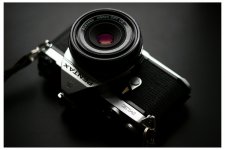
The most simple lens I have is the beautiful Zeiss Triotar 75f/4.5. Of course it shoots medium format so the overall tones are different but it just produces images with so much character, especially wide open.
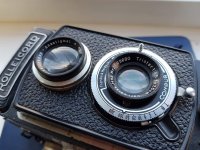
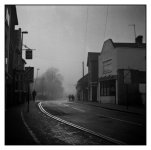
I was never a fan of Tessars. I used one on an Ikoflex and a Yashica Mat and a few M42. The one with the most character was probably the Elmar.
Attachments
Mos6502
Well-known
Some of my favorite cameras have triplet lenses. One of them always delivers beautifully 3D rendering.
 Behind the Arcade by Berang Berang, on Flickr
Behind the Arcade by Berang Berang, on Flickr
 Power by Berang Berang, on Flickr
Power by Berang Berang, on Flickr
I think where a lot of people go wrong is in adopting the idea that a more perfect lens necessarily means a more naturalistic rendering. We don't see the world like a perfect camera. Our vision is not bounded by perfectly straight, evenly bright borders. Our eyes do not see an entire scene in focus at once, they focus on the subject that has our attention, and everything at the edges goes a bit soft. Given these facts, some light fall off, some focus fall off, is not only acceptable from a lens, but often times more "natural" than the perfect rendering. I think the beautiful look given by many old lenses is simply that their faults give a more natural impression of human vision than hyper-corrected modern lenses give.
 Behind the Arcade by Berang Berang, on Flickr
Behind the Arcade by Berang Berang, on Flickr Power by Berang Berang, on Flickr
Power by Berang Berang, on FlickrI think where a lot of people go wrong is in adopting the idea that a more perfect lens necessarily means a more naturalistic rendering. We don't see the world like a perfect camera. Our vision is not bounded by perfectly straight, evenly bright borders. Our eyes do not see an entire scene in focus at once, they focus on the subject that has our attention, and everything at the edges goes a bit soft. Given these facts, some light fall off, some focus fall off, is not only acceptable from a lens, but often times more "natural" than the perfect rendering. I think the beautiful look given by many old lenses is simply that their faults give a more natural impression of human vision than hyper-corrected modern lenses give.
p.giannakis
Pan Giannakis
So, I've always rather liked the 28-80 3.3-5.6G plastic Nikon kit lens produced between 2001-2005. Reading up on this thing on the internet to validate my opinion (nodding my head in approval of those who share my opinion that this is an undervalued little gem of a lens, and shaking my fist at the screen when someone disagrees...)
Ok, you pushed me down the slippery slope of having to snatch this one. Let's see if it worths the £3 I paid for it.
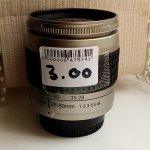
Share:
-
This site uses cookies to help personalise content, tailor your experience and to keep you logged in if you register.
By continuing to use this site, you are consenting to our use of cookies.


